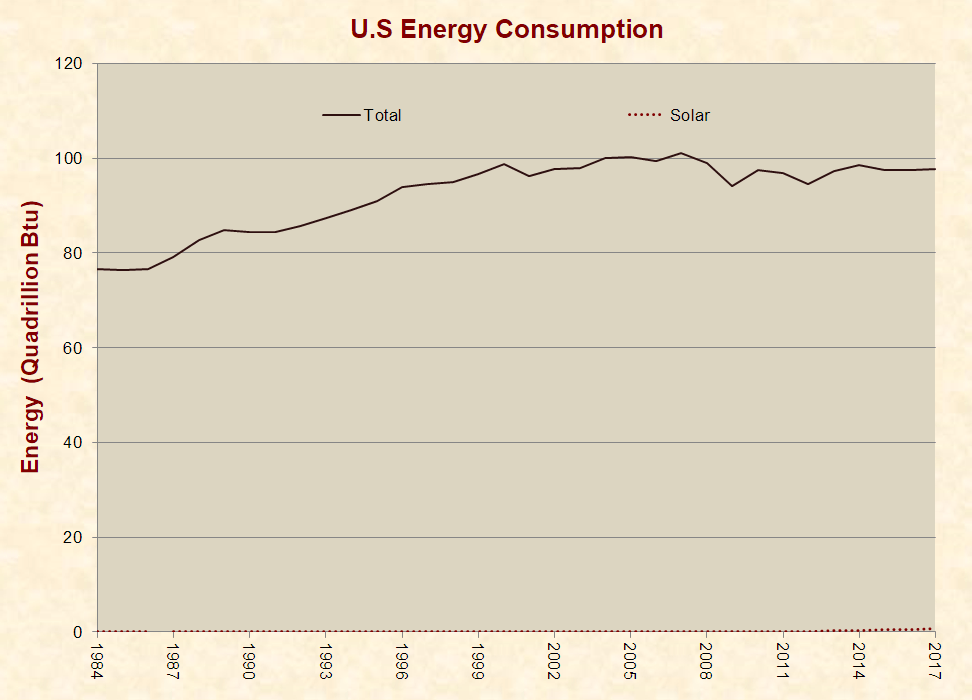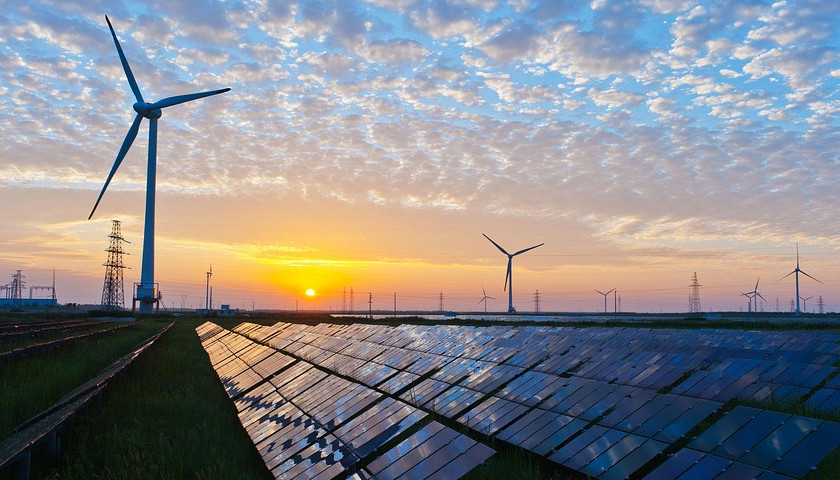by James D. Agresti
The famed SAT, or Scholastic Assessment Test, is a college readiness exam taken by more than 1.6 million students per year. In May of 2018, the College Board, which owns and operates the SAT, required test takers to read an article that claims:
- the cost of solar energy installations “fell by more than 50 percent between 2010 and 2013.”
- “solar power is now competitive with other energy sources in many markets.”
- solar energy is a “ray of sunshine for the U.S. economy.”
This article appeared in the reading portion of the exam, which supposedly uses “authentic texts selected from high-quality” sources. Yet, all of the assertions above are rooted in solar industry propaganda that is at odds with the facts. Moreover, this disinformation misleads students in ways that can cause serious harm.
Cost Declines
In contrast to the SAT’s claim that the cost of solar installations fell by more than 50% from 2010 to 2013, the U.S. Department of Energy’s National Renewable Energy Laboratory reports that “system prices of residential and commercial PV [photovoltaic solar] systems declined 6%–12% per year, on average, from 1998–2014….” This amounts to a decrease during 2010 to 2013 of 17% to 32%, which is far below 50%.
So from where does the SAT get its figure of more than 50%? It doesn’t say, but a likely candidate is an oft-cited report from the U.S. Energy Information Administration [EIA]. This annual report provides estimates of the “levelized costs” of utility-scale electricity, and according to it, the cost of PV solar dropped from $396.1 per megawatthour in 2010 to $144.3 in 2013, or by 64%. Accounting for inflation, this is a decline of 66%, but there is more to this than meets the eye.
Those figures are not hard costs but projections that vary with EIA’s assumptions, which have changed wildly over time. For example, from 2010 to 2011, EIA lowered its solar cost projection by 47%. During that year, EIA changed several assumptions that created an illusion of cost declines, such as increasing the assumed financial life for electric plant capital costs from 20 years to 30 years. Given that capital costs comprised 95% of solar’s total costs in 2010, this change made solar appear to be much less expensive. That is merely an artifact of changing assumptions. It is not an actual decrease in costs.
Like the SAT, solar companies and environmental activists crow about such statistics, but they either fail to understand them or are deliberately misrepresenting them.
Competitiveness
The SAT’s claim that “solar power is now competitive with other energy sources in many markets” also falls apart upon inspection. This is a knotty issue, because determining the relative costs of electricity-generating technologies is complicated by the following factors:
- Utilities must produce enough electricity to meet their customers’ demands on a second-by-second basis, and the costs of generating this electricity vary depending upon when it is produced. During periods of high demand, electricity is more expensive to generate. Thus, technologies that can generate electricity on demand (like natural gas) generally have more value to utilities than intermittent resources that are dependent upon the weather (like wind and solar).
- Power plants and solar panels are capital-intensive and have lifespans measured in decades. Because these are long-term investments, there is ample time for market conditions and government energy policies to change, and this creates uncertainty.
- Decisions to invest in new generating capacity frequently involve factors that are unique to each utility and each point in time.
EIA’s 2018 levelized cost projections show that electricity from new utility-scale solar plants will cost an average of 23% more than natural gas in 2022. This doesn’t account for the facts that:
- intermittent electricity is typically less valuable than electricity from sources that can be dispatched on demand. Thus, EIA states that the levelized costs for wind and solar “are not directly comparable to those for other technologies” and are “listed separately in the tables, because caution should be used when comparing them to one another.”
- rooftop solar systems, which comprise most of the solar capacity in the U.S., are more costly than utility-scale solar systems. Per the National Renewable Energy Laboratory, “rooftop PV is expensive compared to large-scale, ground-mounted systems.” This is mostly because larger systems benefit from economies of scale.
EIA also performs a more complex analysis that provides “a better assessment of economic competitiveness” for differing technologies. In 2013, this analysis projected that the economic value of new utility-scale solar plants in 2018 will be “negative and significantly below” natural gas “in all regions.” In contrast, the 2018 analysis projected that new solar will be a better economic value than every technology but geothermal in 2022.
Regardless, both analyses use assumptions that stack the deck in favor of solar. For example, they assume that all types of generation capacity have the same financial life (30 years), while the reality is that differing technologies have different physical lifespans, and solar is near the bottom of the barrel.
A more concrete indicator of solar’s competitiveness is the actual energy it generates, which amounted to only 0.8% of U.S. energy consumption in 2017 and 0.1% of the world’s energy in 2014. Some say that solar is just starting to be competitive and its future is bright, but EIA projects that solar will still provide less than 1% of the world’s energy in 2050. This is in spite of aggressive government actions to bolster solar, such as these:
- Since the Energy Tax Act of 1978, the U.S. government has continuously provided tax credits for solar energy systems ranging from 10% to 30% of their production or capital costs.
- In 1998, EIA reported: “For many years, state and federal governments, as well as environmentalists and utilities, have strongly supported the use of solar energy—especially in the U.S. Department of Energy’s research and development budget.”
- In 2011, the New York Times reported that “taxpayers and ratepayers are providing subsidies worth almost as much as the entire $1.6 billion cost” for “a compound of nearly a million solar panels,” and “similar subsidy packages have been given to 15 other solar- and wind-power electric plants since 2009.”
- A 2012 Government Accountability Office study found 679 renewable energy-related initiatives in 23 federal agencies.
- In 2016, EIA reported: “More than 70% of [energy-rerated] physical science grants went to solar energy research with virtually all of the remainder for other renewable energy (e.g., fuel cells).”
- States like California and Arizona have forced utilities to purchase electricity from customers with solar panels at rates that don’t account for the transmission or distribution costs of this energy. This pushes these costs—which amount to about 40% of the typical electricity bill—onto other customers.
- 29 states and the District of Columbia require utilities to generate or obtain specified amounts of their electricity from renewable sources like solar.
In conjunction with their efforts to advance solar, federal and state governments have taken steps to reduce the use of fossil fuels through taxes and regulations. They also subsidize some aspects of fossil fuels, mainly for environmental reasons and to give domestic and smaller producers an edge over foreign and larger producers. However, on net, fossil fuels are not subsidized but penalized. For example, direct federal subsidies for gasoline averaged one penny per gallon in 2016, while the federal excise tax on gasoline was 18 cents per gallon.
Even with decades of government interventions to prop up solar and suppress its competitors, solar’s contribution to U.S. energy supplies is so negligible that it can barely be seen in the big picture. The red dotted line along the very bottom of this chart shows what solar has contributed to U.S. energy consumption for the past third of a century:
 This chart also deflates the rhetoric of green energy proponents that boast about solar’s growth. For example, the Center for American Progress states that the U.S. “has experienced a remarkable explosion of innovation and entrepreneurship in clean energy,” with “utility-scale solar electric generation increasing 40-fold” from 2009–2016. Solar’s recent numbers appear large when compared to its past, but these figures are tiny in the broad view of things.
This chart also deflates the rhetoric of green energy proponents that boast about solar’s growth. For example, the Center for American Progress states that the U.S. “has experienced a remarkable explosion of innovation and entrepreneurship in clean energy,” with “utility-scale solar electric generation increasing 40-fold” from 2009–2016. Solar’s recent numbers appear large when compared to its past, but these figures are tiny in the broad view of things.
Jobs
The title of the SAT’s article is “A Ray of Sunshine for the US Economy.” This description supposedly applies to solar because “80,000 jobs” were created in the solar industry from “2010 to 2014.”
That is a naive viewpoint, for as detailed in the book Environmental and Natural Resource Economics: An Encyclopedia, “Growth in the green jobs sector does not necessarily imply net job creation” or economic progress for the following reasons:
- It is “easy to promote job growth in a given activity by simply encouraging (subsidizing) inefficient technologies that are more costly. We could, for example, use picks and shovels to dig for oil,” but this would reduce the nation’s productivity, which is the primary driver of living standards.
- “The end product of a solar array or a wind farm is” electricity output. “Thus, increasing the amount of” output “produced from alternative energy or green energy sources reduces” the output and jobs “that would have been produced from fossil fuels.” Hence, “net job creation may be zero (or negative).”
- “Given the capital-intensive nature of energy development (green or fossil fuels), it is unlikely that this sector would produce as many direct jobs as alternative uses of government support. The benefits would largely accrue to the owners of capital [i.e., business owners].”
One of the most basic concepts in economics (and logic) is weighing costs and benefits. A failure to do this can make virtually anything seem positive or negative. Yet, the SAT ignored this essential principle of sound analysis and fed students a narrow, biased view of this issue. This is ironic given that the SAT aims to “measure students’ critical thinking and problem-solving abilities” and claims to be “evidence based in design and content.”
Environmental Effects
The SAT also asserts that “technological and economic developments in the solar-power industry” are “helping the environment.” This claim rests on shaky ground, because:
- manufacturing PV solar systems creates significant amounts of pollution.
- the total energy generated by solar is so low that it does not displace enough fossil fuels to cause substantive environmental impacts.
- the high costs of solar cause people to use primitive energy sources that create far more pollution than commercial energy technologies.
Assessing the full environmental impacts of energy sources requires looking at their entire life cycles, not just their emissions while they are operating. Per the journal Environmental Science & Technology, all manmade:
means of generating energy, including solar electric, create pollutants when their entire life cycle is taken into account. Life-cycle emissions result from using fossil-fuel-based energy to produce the materials for solar cells, modules, and systems, as well as directly from smelting, production, and manufacturing facilities.
Measuring just one of those factors, a 2013 paper in Environmental Science & Technology calculated that the global PV solar industry consumed more total energy since 2000 than it produced, and the industry will become energy-neutral “before 2020.” In other words, the analysis found that solar is now just reaching the point where it has created as much energy as it has consumed since 2000. This suggests that solar’s net environmental impact to date is essentially zero, and this doesn’t account for:
- the direct pollution caused by solar manufacturing processes like raw material extraction and smelting.
- the pollution caused by the disposal of solar systems at the end of their lives.
- solar’s record before 2000, when the technology was less developed and consumed more energy relative to its production.
Lifecycle analyses of PV solar generally find that it creates far less pollutants than fossil fuels, but any environmental benefits are mitigated by the fact that solar provides well under 1% of the world’s energy. Thus, even if solar were pollution-free, it would only eliminate a miniscule portion of the world’s energy pollution, much less its overall pollution. This may not be enough to make any practical difference to the environment. Moreover, it may be overwhelmed by another factor that is rarely, if ever, accounted for in such analyses.
When modern energy is unavailable or expensive, people tend to burn more wood, crop waste, manure, and coal in open fires and home stoves. These do not burn fuel as efficiently as commercial energy technologies, and hence, they produce elevated levels of outdoor and indoor pollutants. The added consumption of wood also causes deforestation.
As explained by the World Health Organization: “Around 3 billion people still cook using solid fuels,” and this creates “high levels of household air pollution with a range of health-damaging pollutants, including small soot particles that penetrate deep into the lungs.” Additionally: “Exposure is particularly high among women and young children, who spend the most time near the domestic hearth.”
When nations pour money into energy systems that produce less energy for the same costs as other technologies, more people use primitive energy sources that churn out pollutants. This is especially true in developing nations, but it also applies in developed countries like Germany and Greece, where high energy prices have driven people to pillage the nations’ forests for wood.
The case of Germany is particularly instructive, because environmentalists have touted it as proof that nations “can reliably and affordably integrate high levels of solar energy into their electricity mix.” The facts of the matter belie that rhetoric:
- Solar provides 6.1% of Germany’s electricity (not its total energy; just its electricity).
- The average residential electricity price in Germany is three times higher than in the U.S., with taxes and levies for green energy projects accounting for about half of German households’ electricity bills.
- The German newspaper Der Spiegel reported in 2013:
- “With energy costs escalating, more Germans are turning to wood burning stoves for heat.”
- “The number of Germans buying heating devices that burn wood and coal has grown steadily since 2005,” which has “boosted prices for wood, leading many to fuel their fires with theft.”
- “About 10 percent of the firewood that comes out of Brandenburg’s forest every year is stolen….”
Statically speaking, solar is cleaner than coal and natural gas, but when real-world dynamics are considered, opting for solar over fossil fuels may produce more total pollution. This is because solar creates less electricity per dollar, thus driving people to burn more wood, manure, and coal in stoves and pits.
Given the facts above and the inherent uncertainty of many environmental analyses, the SAT’s claim that solar is “helping the environment” does not stand up to scrutiny.
The Harm
When students are led to believe things about solar energy that aren’t true, they are groomed to support policies that align with those falsehoods. As with many issues, the ramifications of this can be serious. This is because—unlike solar’s energy output—the ability of “green” policies to raise energy prices is substantial.
That is evident from electricity prices in Germany and from an Obama administration analysis of climate change regulations. In 2013, the U.S. Energy Information Administration (a division of the Department of Energy) estimated that President Obama’s regulatory agenda for greenhouse gases would add 30% to the cost of electricity by 2022. This accords with Obama’s earlier statement that “electricity rates would necessarily skyrocket” under his plan to stem global warming. This is not likely to occur, since President Trump has begun repealing Obama’s climate change regulations.
Because energy is such a crucial element of the economy, rising energy prices can increase unemployment, decrease wages, raise the cost of food, and cause other harmful effects. This generally hurts impoverished people the most. In Haiti, higher energy prices during 2007 and 2008 contributed to increased food prices, which drove Haiti’s poor to obtain nourishment from cookies made of mud.
A recent study in the journal Nature Climate Change explains that efforts to prevent climate change can “negatively affect food security, due to indirect impacts on prices and supplies of key agricultural commodities.” The authors conducted “a multiple model assessment” of these factors and found that:
by 2050, stringent climate mitigation policy, if implemented evenly across all sectors and regions, would have a greater negative impact on global hunger and food consumption than the direct impacts of climate change. The negative impacts would be most prevalent in vulnerable, low-income regions such as sub-Saharan Africa and South Asia, where food security problems are already acute.
This study, like all such studies, should be taken with a grain of salt. This is because the full costs and benefits of government policies can be very difficult (and often impossible) to objectively quantify. Per the textbook Microeconomics for Public Decisions, it is “relatively easy” to craft a cost-benefit analysis to “produce a desired outcome,” and “it is practically impossible to predict all the future impacts” of a government program, “let alone their magnitudes and their probabilities of occurrence.”
All of this illustrates why it is critically important that explanations of these issues are accurate and evenhanded. The SAT failed to do that when it published this error-filled, slanted article in its exam.
– – –
James D. Agresti is the president of Just Facts, a think tank dedicated to publishing rigorously documented facts about public policy issues. He holds a Bachelor of Science in Mechanical Engineering from Brown University and has worked as a designer of jet engine components and systems, a technical sales professional, and chief engineer of a firm that customizes helicopters. He is also the author of Rational Conclusions, a meticulously researched and acclaimed book evidencing factual support for the Bible across a broad array of academic disciplines.






Question: How many “greenie” solar energy profiteers does it take to power a light bulb?
Answer: We will never know because they cannot find a sucker to pay for it.